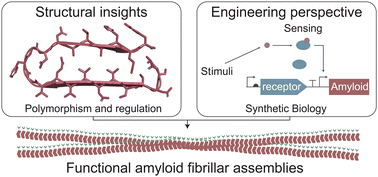Rational design of functional amyloid fibrillar assemblies
Abstract
Amyloid fibrillar assemblies, originally identified as pathological entities in neurodegenerative diseases, have been widely adopted by various proteins to fulfill diverse biological functions in living organisms. Due to their unique features, such as hierarchical assembly, exceptional mechanical properties, environmental stability, and self-healing properties, amyloid fibrillar assemblies have been employed as functional materials in numerous applications. Recently, with the rapid advancement in synthetic biology and structural biology tools, new trends in the functional design of amyloid fibrillar assemblies have begun to emerge. In this review, we provide a comprehensive overview of the design principles for functional amyloid fibrillar assemblies from an engineering perspective, as well as through the lens of structural insights. Initially, we introduce the fundamental structural configurations of amyloid assemblies and highlight the functions of representative examples. We then focus on the underlying design principles of two prevalent strategies for the design of functional amyloid fibrillar assemblies: (1) introducing new functions via protein modular design and/or hybridization, with typical applications encompassing catalysis, virus disinfection, biomimetic mineralization, bio-imaging, and biotherapy; and (2) dynamically regulating living amyloid fibrillar assemblies using synthetic gene circuits, with typical applications in pattern formation, leakage repair, and pressure sensing. Next, we summarize how breakthroughs in characterization techniques have contributed to unveiling the structural polymorphism of amyloid fibrils at the atomic level, and further clarifying the highly diverse regulation mechanisms of amyloid fibrillar assembly and disassembly fine-tuned by various factors. The structural knowledge may significantly aid in the structure-guided design of amyloid fibrillar assemblies with diverse bio-activities and adjustable regulatory properties. Finally, we envision that a new trend in functional amyloid design may emerge by integrating structural tunability, synthetic biology and artificial intelligence.



 Please wait while we load your content...
Please wait while we load your content...